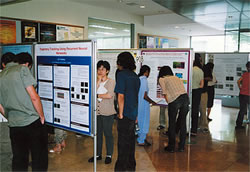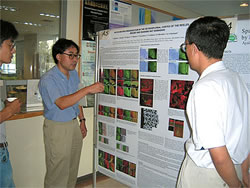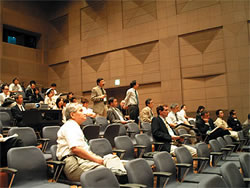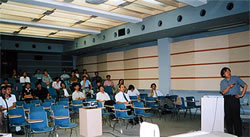BSI Summer Program 2004
BSI Summer Program 2004, which started in July, completed successfully at the end of August. 46 participants representing universities, colleges and research institutes from 14 countries around the world joined either the lecture course or the internship course of this year’s program.
The theme of the two week lecture was “Learning and Memory: Systems, Theories, and Molecules.” Distinguished lecturers were invited from around the world to speak. Lectures covered basic and advanced research in the fields of learning and memory systems. Active discussions between the Program participants, BSI researchers and lecturers also took part.
Participants in the internship conducted research over a period of about two months in one of the hosting laboratories of BSI. They actively acquired technical skills and conducted experiments during the course of the internship. At the end of the internship, each participant presented a poster of the results of the research conducted at the BSI.
Poster sessions and laboratory visits occurred over the course of the program that also fostered meaningful research exchange between participants and BSI members.
BSI will continue the Summer Program in the coming years to provide students with opportunities to interact and collaborate with researchers from BSI, Japan and other countries around the world. This will provide participants the opportunity to contribute to the worldwide development of the brain sciences. The program will also lead to qualitative improvements in BSI and enable greater contribution to the brain sciences.
For details of the Summer Program for next year, please visit the BSI website at (http://www.brain.riken.jp/summer.html).
Workshop: The Cortical Pyramidal Neuron in 2004
Pyramidal neurons are the most abundant cell type in the cerebral cortex. As the main source of cortical outputs, these cells have long attracted attention; and, as previously noted by Dr. Goldman-Rakic, were designated even by Cajal as “psychic neurons.” Nevertheless, by comparison with cortical interneurons, work on pyramidal neurons concerning their subtype diversity, local circuitry, and functional neuronal groups can be seen as lagging behind. With these issues in mind, the Cognitive Brain Science Group recently organized a Workshop (August 19, 20) with the theme: “The Cortical Pyramidal Neuron in 2004.” Workshop goals were 1) to review progress, 2) to promote discussion about fruitful directions, and 3) to encourage renewed interest in this field.
In his welcoming remarks, Dr. Keiji Tanaka emphasized the importance of cortical cellular populations and their local and long distance connectivity for understanding the substrates of cognitive processes. Dr. Peter Somogyi (Oxford University) then spoke on cell types and the design of circuits in the hippocampus and neocortex. Dr. Kathleen S. Rockland (Head, Laboratory for Cortical Organization and Systematics, BSI) presented new findings about a honeycomb- like modularity in layers 1,2, in part involving zinc-enriched excitatory terminations. Dr. Yuji Ikegaya (Columbia University) talked about modular dynamics of spontaneous activity ensembles (“synfire chains and cortical songs”) in neocortex Dr. Yoshiyuki Kubota (Natl. Inst. for Physiol. Sci.) showed evidence, based on EM reconstructions , that different types of double bouquet interneurons have several specific synaptic targets, both pyramidal and nonpyramidal. Dr. Takeshi Kaneko (Kyoto University) demonstrated several aspects of celltype specific connectivity in rat motor cortex; for example, that corticospinal neurons in layer 5 receive information from the superficial layers differently (4-times as efficiently) than do corticothalamic neurons in layer 6. Participation was active and further discussion continued at two poster sessions, where 11 posters were presented by BSI scientists and collaborators.
2nd International Workshop on “Frontiers in Molecular Neuropathology”
On September 30th and October 1st 2004, RIKEN BSI Molecular Neuropathology Group and the “Japanese Society for Dementia Research” jointly hosted the second international workshop for “Frontiers in Molecular Neuropathology”. This year’s meeting was held at Tower Hall Funabori in Tokyo. Following the success of the first workshop in 2002, Dr. Nobuyuki Nukina, Group Director of the Molecular Neuropathology Group at RIKEN BSI, was appointed chair of the Japanese Society of Dementia Research. Therefore it was decided that for the second international workshop the number of sessions related to Alzheimer’s disease should be expanded to make the session a joint meeting.
Discussions on progress in research into Alzheimer’s disease were promoted by inviting Dr. De Strooper (VIB abd K.U. Leeven, Belgium), Dr. M.C. Irizarry (Harvard University), Dr. T. Seabrook (Harvard University) and Dr. T. Iwatsubo (University of Tokyo). Dr. Takaomi Saido (Head, Laboratory for Proteolytic Neuroscience) and Dr. Akihiko Takashima (Head, Laboratory for Alzheimer’s Disease) participated on behalf of RIKEN. The participants presented the results of their latest research into γ-secretase, immunotherapy, Aβ proteolysis and tau protein. Presentations about neurodegenerative disorders were made by Dr. B. Liu (Stanford University) and Dr. Ryosuke Takahashi (Head, Laboratory for Motor System Neurodegeneration ) on Parkinson’s disease; Dr. Cleveland (UCSD) on ALS; and Dr. D.C. Rubinsztein (Cambridge University), Dr. I. B. Bezprozvanny (UT), Dr. A. La Spada (University of Washington) and Dr. Nukina on polyglutamine diseases.
Reports covering many topics at the forefront of current pathological research were also presented. Interesting and active discussions followed, not just following lectures but during social gatherings and breaks as well. This joint workshop with the Japanese Society of Dementia Research was attended by 250 participants on the first day and 150 on the second. Those participating from the Japanese Society of Dementia Research appreciated the opportunity to review work on various neurodegenerative disorders in addition to Alzheimer’s disease. Research into the neural diseases has recently shown remarkable advances, and the Molecular Neuropathology Group of BSI hopes offer more workshops of this kind in the future.
CDB (Kobe) - DRI (Wako) -BSI Joint Forum
A joint forum between the Kobe Center for Developmental Biology (CDB), the Wako Discovery Research Institute (DRI), and BSI was held at Okochi Hall (Wako) on September 13 and 14, 2004 . This was the fourth joint forum between CDB and BSI in the past year, and the first joined by DRI. This was also the first trilateral meeting between the Kobe and Wako Institutes. These forums hope to address increasing demands for more partnership and cooperation within RIKEN and encourage more interaction between research centers.
Members of each institute gave presentations on hot topics that were followed by lively question and answer sessions. Dr. Masatoshi Takeichi, the director of CDB, spoke about the role of αN-catenin in synapse stability and BSI’s Katsuhiko Mikoshiba talked about Ca2+ signaling in development and cell function. They spoke before a multi-disciplined audience representing many different fields of study. Other activities, such as a retreat around May of next year that would include the Yokohama Institute, are also being planned to further strengthen cooperative relationships within RIKEN.









